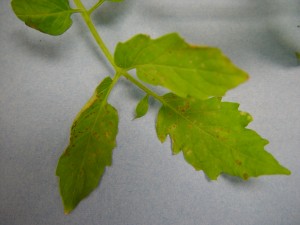What Is It? | Facts in Depth | For the Professional Diagnostician
Tomato Diseases | Bacterial Leaf Spot Fact Sheets
Bacterial Leaf Spot of Tomato
Identification
Seedlings:
- Originate from seed
- Small, greasy water-soaked spots (1/8 inch) on leaflets
Plants:
- Greasy water-soaked spots on leaflets
- Older spots are dry and brown and often surrounded by yellow halos
- Spots increase in size to form large irregular dead spots
- Spots are most often observed on the entire surface of fully expanded leaves by may also appear on the steam and the flower bugs
- Severe infections may cause the plant to lose its leaves.



Fruit:
- Small, greasy water-soaked spots on the green fruit that become slightly raised and enlarged (1/4 inch)
- Older spots are irregular in shape, light brown to black, slightly sunken and have a scabby surface texture



Favorable Environmental Conditions
- Warm temperatures (75-90 °F)
- High moisture
- High relative humidity
Often Confused With

Scouting Notes
- The pathogen can be active from the time of plant emergence through to harvest.
- Foliar symptoms of bacterial spot and speck are identical.
- Fruit symptoms are diagnostic, based on spot size, appearance and texture.
- Early spots can appear whitish, resembling bacterial canker “bird’s eye” spots
- Greenhouse seedlings and plants in the field should be monitored weekly for early symptoms and suspect plants should be sampled and submitted for plant disease diagnosis.
